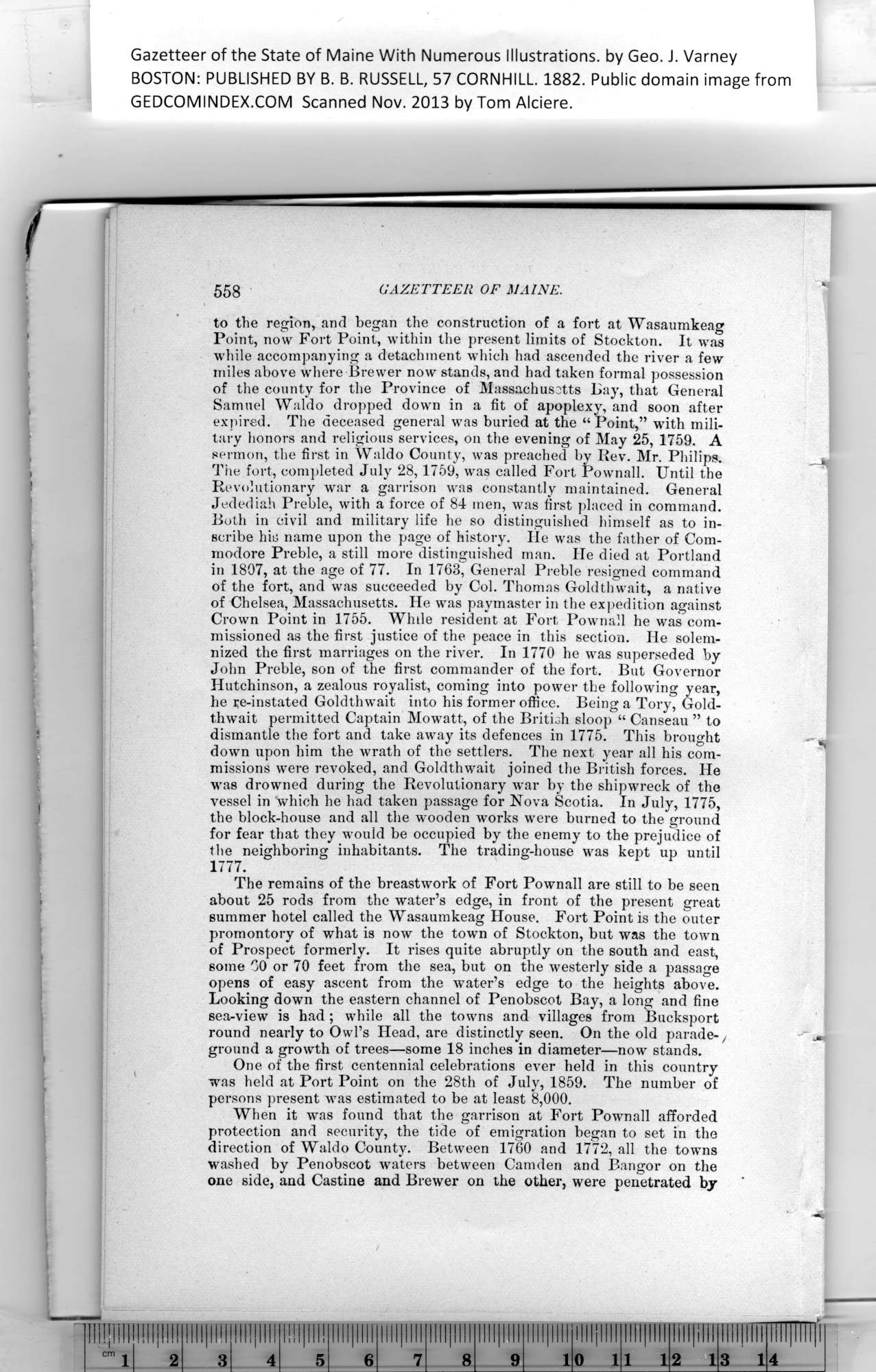|
Gazetteer of the State of Maine With Numerous Illustrations, by Geo. J. Varney
BOSTON: PUBLISHED BY B. B. RUSSELL, 57 CORNHILL. 1882. Public domain image from
558 GAZETTEER OF MAINE.
to the region, and began the construction of a fort at Wasaumkeag
Point, now Fort Point, within the present limits of Stockton. It was
while accompanying a detachment which had ascended the river a few
miles above where Brewer now stands, and had taken formal possession
of the county for the Province of Massachusetts Bay, that General
Samuel Waldo dropped down in a fit of apoplexy, and soon after
expired. The deceased general was buried at the “ Point,” with mili-
tary honors and religious services, on the evening of May 25, 1759. A
sermon, the first in Waldo County, was preached by Rev. Mr. Philips.
The fort, completed July 28, 1759, was called Fort Pownall. Until the
Revolutionary war a garrison was constantly maintained. General
Jedediah Preble, with a force of 84 men, was first placed in command.
Both in civil and military life he so distinguished himself as to in-
scribe his name upon the page of history. He was the father of Com-
modore Preble, a still more distinguished man. He died at Portland
in 1807, at the age of 77. In 1763, General Preble resigned command
of the fort, and was succeeded by Col. Thomas Goldthwait, a native
of Chelsea, Massachusetts. He was paymaster in the expedition against
Crown Point in 1755. While resident at Fort Pownall he was com-
missioned as the first justice of the peace in this section. He solem-
nized the first marriages on the river. In 1770 he was superseded by
John Preble, son of the first commander of the fort. But Governor
Hutchinson, a zealous royalist, coming into power tbe following year,
he re-instated Goldthwait into his former office. Being a Tory, Gold-
thwait permitted Captain Mowatt, of the British sloop “ Canseau ” to
dismantle the fort and take away its defences in 1775. This brought
down upon him the wrath of the settlers. The next year all his com-
missions were revoked, and Goldthwait joined the British forces. He
was drowned during the Revolutionary war by the shipwreck of the
vessel in which he had taken passage for Nova Scotia. In July, 1775,
the block-house and all the wooden works were burned to the ground
for fear that they would be occupied by the enemy to the prejudice of
the neighboring inhabitants. The trading-house was kept up until
1777.
The remains of the breastwork of Fort Pownall are still to be seen
about 25 rods from the water’s edge, in front of the present great
summer hotel called the Wasaumkeag House. Fort Point is the outer
promontory of what is now the town of Stockton, but was the town
of Prospect formerly. It rises quite abruptly on the south and east,
some 60 or 70 feet from the sea, but on the westerly side a passage
opens of easy ascent from the water’s edge to the heights above.
Looking down the eastern channel of Penobscot Bay, a long and fine
sea-view is had ; while all the towns and villages from Bucksport
round nearly to Owl’s Head, are distinctly seen. On the old parade-,
ground a growth of trees—some 18 inches in diameter—now stands.
One of the first centennial celebrations ever held in this country
was held at Port Point on the 28th of July, 1859. The number of
persons present was estimated to be at least 8,000.
When it was found that the garrison at Fort Pownall afforded
protection and security, the tide of emigration began to set in the
direction of Waldo County. Between 1760 and 1772, all the towns
washed by Penobscot waters between Camden and Bangor on the
one side, and Castine and Brewer on the other, were penetrated by
PREVIOUS PAGE ... NEXT PAGE
This page was written in HTML using a program written in Python 3.2
|
